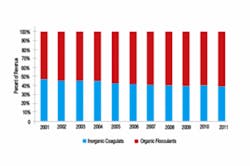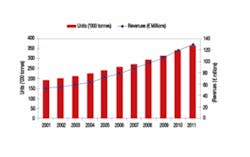Regulatory compliance drives demand for water treatment chemicals
European Union (EU) directives to boost the use of water treatment chemicals in Central and Eastern Europe.
Demand for water treatment chemicals, including coagulants and flocculants, is surging following the accession of eight central and eastern European (CEE-8) countries - Poland, the Czech Republic, Slovakia, Hungary, Slovenia, Lithuania, Latvia and Estonia - into the European Union (EU) in 2004.
The need to align national legislation with EU directives on drinking water and urban wastewater is expected to push revenues for coagulants and flocculants from an estimated e62.1 million in 2004 to nearly e129.0 million in 2011.
The EU Urban Wastewater Management and the European Water Framework Directives are the key catalysts driving growth for water treatment chemicals in the CEE region. New EU regulations relating to the quality of industrial effluents are compelling the industrial sector to treat its wastewater rather than release it untreated into local streams. Efforts to meet deadlines for the implementation of EU guidelines are driving municipalities to build new wastewater treatment plants.
While EU regulations are undoubtedly increasing demand for water treatment chemicals in CEE, a key challenge remains the lack of financial resources in both the municipal and the industrial sectors. Monetary support from the European Bank for Reconstruction and Redevelopment (EBRD), the World Bank, as well as private investments is likely to provide the financial backing for modernising water treatment plants and implementing stringent EU regulations on water quality.
However, unless an effective executive framework for enforcement of these EU regulations is set up industrial plants are likely to keep investments in nonessential water treatment to a minimum.
Revenues are increasing faster than volumes as suppliers increase prices in response to high raw material and transportation costs. While the compound annual growth rate (CAGR) for revenues in the CEE coagulants and flocculants market is projected to be 11.0 percent over the time period 2004-2011, the CAGR for unit shipments over the same period is estimated at 7.1 percent.
In volume terms, both organic flocculants and inorganic coagulants are expected to grow at the same rate (a CAGR of 7.1 percent). Revenues are expected to increase faster for organic flocculants; a CAGR in revenues of 12.8 percent from 2004 to 2011 compared to inorganic coagulants, which are expected to grow at a CAGR of 8.6 percent.
The approaching maturation of the Czech and Polish markets is likely to be balanced by high growth in Hungary, Slovenia and the Baltic States.
Healthy economic growth, increased renovation of water treatment plants in addition to new building activities are driving demand for water treatment chemicals in the Baltic States. Privatisation of its largely underdeveloped municipal water treatment system is propelling demand for coagulants and flocculants in the Hungarian market. Industrial expansion, together with developments in the municipal water treatment market, is expected to support strong growth in Slovakia.
Prospective EU accession states, Romania and Bulgaria, are also exhibiting immense potential; these countries are intensifying their efforts to improve water and wastewater infrastructure in preparation for their induction into the EU.
Establishment of a company’s physical presence on the market is the one most important competitive factor; in a market where most business decisions are founded on personal relationships, local representatives in the field with a good network of contacts are essential to addressing regional cultural differences and achieving success.
Author's Note
Industry Analyst Evelyne Turmes of Frost & Sullivan specializes in the sectors of chemicals, materials and foods within Central and Eastern Europe. For more information, visit the website www.frost.com.


